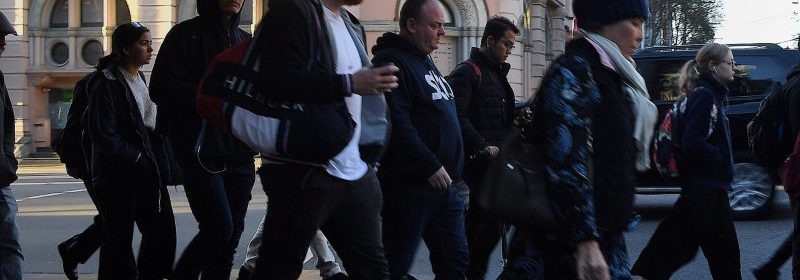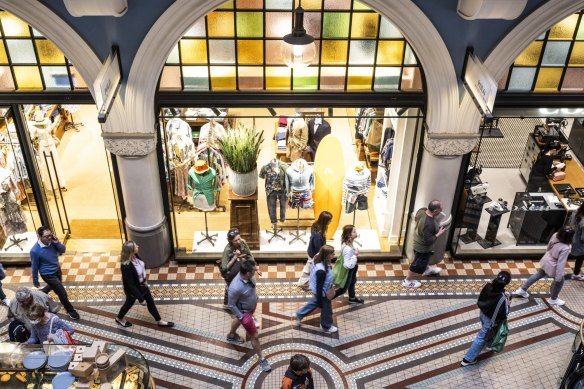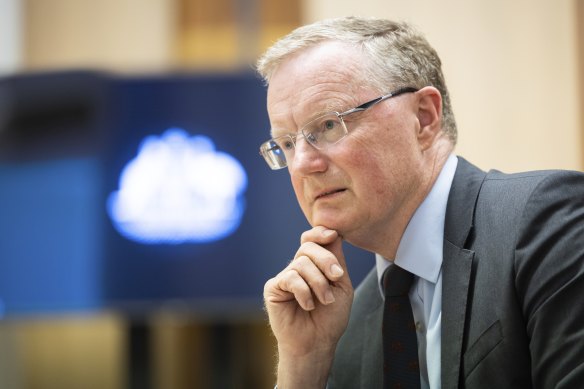The hard times are coming for the Australian economy

It’s clear the economy’s started slowing, with the strong bounceback from the lockdowns nearing its end. That’s before we’ve felt much drag from the big rise in interest rates. Or the bigger economies pulling us lower, which is in store for next year.
To be sure, the economy’s closer to full employment than we’ve been half a century. But limiting the decline from here on will be a tricky task for Anthony Albanese and, more particularly, Reserve Bank governor Philip Lowe.
Strong consumer spending was the main thing keeping the economy expanding last quarter.Credit:Louise Kennerley
The Australian Bureau of Statistics’ “national accounts” for the three months to the end of September, published this week, showed real gross domestic product – the nation’s total production of goods and services – growing by just 0.6 per cent during the quarter, and by 5.9 per cent over the year to September.
Focus on the 0.6 per cent, not the 5.9 per cent – it’s ancient history. Most of it comes from huge growth of 3.8 per cent in the December quarter of last year, which was the biggest part of the bounceback following the end of the second lockdown of NSW, the ACT and Victoria.
Since then, we’ve had quarterly growth of 0.4 per cent, 0.9 per cent and now 0.6 per cent. That’s the slowing. Quarterly growth of 0.6 per cent equals annualised growth of about 2.5 per cent. That’s about the speed the economy was growing at before the pandemic, which we knew was on the weak side.
Dig deeper into the figures, and you see more evidence of slowing. Strong spending by consumers was pretty much the only thing keeping the economy expanding last quarter. Consumption grew by a seemingly healthy 1.1 per cent, which accounted for all the growth in GDP overall of 0.6 per cent. The various other potential contributors to growth – business investment spending, new home building, exports and so forth – cancelled each other out.
Much of the strong consumer spending that kept the economy moving last quarter was driven by life getting back to normal after the lockdowns… A temporary catch-up, that won’t continue for long.
But get this: that growth of 1.1 per cent was half what it was in the previous quarter. And what were the main categories of strong spending by consumers? Spending in hotels, cafes and restaurants was up by 5.5 per cent in the quarter.
Spending on “transport services” – mainly domestic and overseas travel – was up almost 14 per cent. And purchase of cars was up 10 per cent.
Anything strike you about that list? It’s consumers still catching up after the end of the lockdowns, when most people were still earning income, but were prevented from spending it. We couldn’t go out to hotels, cafes and restaurants, interstate travel was restricted, and overseas holidays were verboten.
As for buying a new car, an earlier global shortage of silicon chips and container shipping mean few were coming into the country.
Get it? Much of the strong consumer spending that kept the economy moving last quarter was driven by life getting back to normal after the lockdowns and the easing of pandemic-caused supply shortages. It’s a temporary catch-up, that won’t continue for long.
Now let’s look at what the quarterly accounts tell us about the state of households’ finances. Despite their strong consumer spending, their real disposable income actually fell a fraction during the quarter, taking the total fall over the year to September to 2.6 per cent.
Why did households’ income fall? Because prices rose faster than wages did. How did households increase their spending while their income was falling? By cutting the proportion of their incomes they’d been saving rather than spending.
After the first lockdown in 2020, the household saving rate leapt to more than 19 per cent of disposable income. Why? Because people had lots of income they simply couldn’t spend.
RBA governor Philip Lowe has a difficult job on his hands. Credit:Alex Ellinghausen
But the rate of saving has fallen sharply since then. And in the September quarter it fell from 8.3 per cent of income to 6.9 per cent – almost back to where it was before the pandemic.
As Callam Pickering, of the Indeed jobs site, explains, “households have been relying on their savings, accrued during the pandemic, to maintain their spending in recent quarters”. Lately, however, they’ve “been hit from all angles, with high inflation, falling [house] prices and mortgage repayments all weighing heavily on household budgets”.
“As household saving continues to ease, the ability of households to absorb the impact of higher prices and rising interest rates will also diminish,” he says.
By the end of September, the hit from higher interest rates was just getting started. Of the 3 percentage-point increase in the official interest rate we know has happened, only 0.75 percentage points had yet reached home borrowers.
So, the hit to growth from government monetary policy is only starting. As for the other policy arm, fiscal policy, we know from the October budget it won’t be helping push the economy along. And in the September quarter, falling spending on infrastructure caused total public sector spending to subtract a little from overall growth in GDP.
A similar subtraction came from net exports. Although the volume of exports rose by 2.7 per cent during the quarter, the volume of imports rose by more – 3.9 per cent. A big part of this net subtraction came from the reopening of our international borders. Our earnings from incoming travellers rose by 18.6 per cent, whereas the cost of our own overseas travel jumped by 58 per cent.
Finally, self-righteous business people are always telling us that if we want to real wages to rise rather than fall, there’s an obvious answer: we’ll have to raise our productivity.
Sorry, not so simple, preacher-man. The accounts show that real labour costs to employers per unit of output fell by 2.6 per cent over the year to September.
Meaning that after allowing for the productivity improvement the nation’s employers gained, the increase in wages and other labour costs were a lot less than the increase in the prices they charged.
This suggests business profits are much better placed to weather next year’s hard times than their workers’ and customers’ pockets are. Not a good omen.
Ross Gittins is the economics editor.
The Business Briefing newsletter delivers major stories, exclusive coverage and expert opinion. Sign up to get it every weekday morning.
Most Viewed in Business
From our partners
Source: Read Full Article


